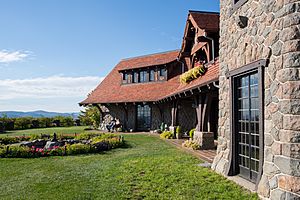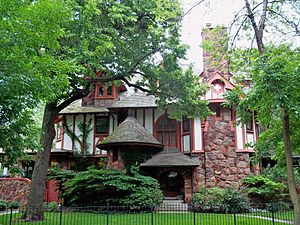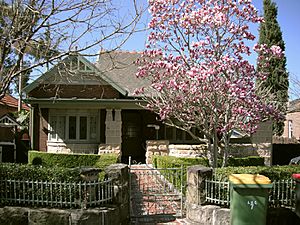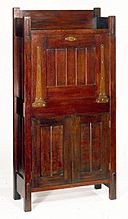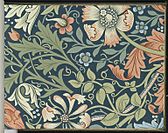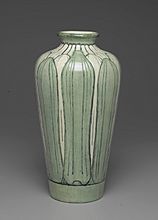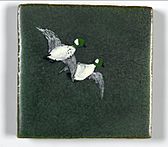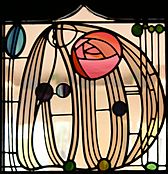Arts and Crafts movement facts for kids

The Arts and Crafts movement was a popular style in art and design that started in the British Isles. It then spread to other parts of the world, like Europe and America.
This movement began around 1880 and lasted until about 1920. It was a reaction against the way things were being made in factories. Artists and designers felt that factory-made items lacked beauty and soul. The Arts and Crafts movement focused on traditional craftsmanship and often used styles inspired by the Middle Ages, romantic ideas, or folk art. It also supported social changes and was against too much industrialization. This movement had a big impact on art in Europe until the 1930s. Its ideas continued to influence craft makers and designers for a long time.
The name "Arts and Crafts" was first used in 1887 by T. J. Cobden-Sanderson. However, the ideas behind it had been growing in England for about 20 years. Key thinkers like historian Thomas Carlyle, art critic John Ruskin, and designer William Morris inspired the movement. In Scotland, important figures like Charles Rennie Mackintosh were part of it.
Contents
Why the Arts and Crafts Movement Started
Improving Design and Art
The Arts and Crafts movement grew from efforts to make design and decoration better in Britain during the mid-1800s. People felt that the quality of art and crafts was getting worse because of machines and factory production. They saw many items at the the Great Exhibition of 1851 that they thought were too fancy, fake, and didn't respect the materials used.
Some early design reformers, like Henry Cole and Owen Jones, didn't like the overly decorated and poorly made goods. They believed in simpler, more practical designs. Their ideas led to books like The Grammar of Ornament, which taught good design principles.
However, these early reformers mostly focused on how things looked, not how they were made. They didn't really criticize factories. The Arts and Crafts movement went further. It was about both design and social change. Its leaders believed that these two things couldn't be separated.
Ideas from A. W. N. Pugin
Some ideas of the Arts and Crafts movement came from Augustus Pugin (1812–1852). He was a leader in bringing back the Gothic style in architecture. Pugin believed that buildings should be honest about their materials, structure, and purpose. This was a key idea for Arts and Crafts artists.
Pugin also compared the problems of modern society, like growing cities and how the poor were treated, to the Middle Ages. This way of thinking became common with Ruskin, Morris, and the Arts and Crafts movement. Pugin's book Contrasts (1836) showed bad modern buildings next to good medieval ones. His simple furniture designs, like "rush chairs, oak tables," were like an early version of the Arts and Crafts interior style.
John Ruskin's Influence
The Arts and Crafts ideas were largely based on John Ruskin's social criticisms. He was greatly influenced by Thomas Carlyle. Ruskin believed that a country's moral and social health was connected to the quality of its buildings and the type of work people did.
Ruskin thought that the machine-made products and specialized jobs created by the industrial revolution made workers like "servants." He felt that a healthy society needed independent workers who could design what they made. He believed factory-made items were "dishonest." He thought that handmade crafts brought dignity to work. His followers preferred handmade goods over factory production. They were worried about losing traditional skills. However, they were more concerned about the effects of the factory system on people than about machines themselves.
William Morris's Vision
William Morris (1834–1896) was a very important figure in design during the late 1800s. He was the main influence on the Arts and Crafts movement. The movement's artistic and social ideas grew from his thoughts. He developed these ideas in the 1850s with friends at the University of Oxford. They loved Romantic literature and wanted to improve society. They were inspired by medieval stories and aimed to fight against the problems of their time.

Morris started trying out different crafts and designing furniture and interiors. He was involved in making things himself, not just designing them. This was a key feature of the Arts and Crafts movement. Ruskin had argued that separating the design process from the actual making of an object was bad for both society and art. Morris took this idea further. He insisted that he would personally learn the techniques and materials before any work was done in his workshops. He believed that "without dignified, creative human occupation people became disconnected from life."
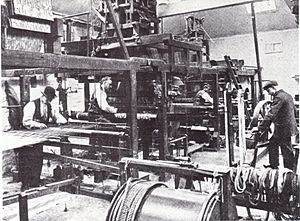
In 1861, Morris began selling furniture and decorative items. His designs were based on medieval styles, using strong shapes and bold colors. His patterns often featured plants and animals. His products were inspired by the simple, traditional styles of the British countryside. Some items were left slightly unfinished to show the beauty of the materials and the craftsman's work, giving them a rustic look. Morris wanted to bring all the arts together in home decoration, focusing on nature and simple forms.
Ideas and Goals of the Movement
Views on Industry
William Morris agreed with Ruskin's criticism of industrial society. He often spoke against modern factories, machines, specialized labor, and the loss of traditional craft methods. However, his feelings about machines were not always the same. Sometimes he said machine production was "altogether an evil." But other times, he would hire manufacturers who used machines if they could meet his high quality standards.
Morris believed that in a "true society," where only useful and beautiful things were made, machines could be improved. They could then be used to reduce the hours people had to work. Historian Fiona MacCarthy noted that Morris didn't have a problem with machines themselves. He only cared if they produced the quality he needed.
Morris insisted that artists should be craftspeople who work by hand. He wanted a society of free craftspeople, like he believed existed in the Middle Ages. He wrote that because craftspeople enjoyed their work, the Middle Ages was a great time for common people's art. He said that the treasures in museums today were once just everyday items used in homes back then. Medieval art and life were seen as ideal by the movement.
Morris's followers also had different ideas about machines and factories. For example, C. R. Ashbee, a key figure, said in 1888, "We do not reject the machine, we welcome it. But we would desire to see it mastered." After trying to make his craft guild work against modern factory methods, he admitted that "Modern civilisation rests on machinery." But he still criticized the bad effects of what he called "mechanism."
Not all Arts and Crafts artists made every part of their goods themselves. It was only later, in the 1900s, that this became a strict rule for defining craftsmanship. Morris himself got hands-on experience in many crafts like weaving and printing. But he didn't see a problem with designers and makers being separate in his factory.
Socialist Ideas
Many Arts and Crafts designers were socialists. This included Morris, T. J. Cobden Sanderson, Walter Crane, C.R. Ashbee, and Philip Webb. In the early 1880s, Morris spent more time promoting socialism than designing. Ashbee even started a community of craftspeople called the Guild of Handicraft. It was based on medieval guilds and aimed to give working men satisfaction in their craft.
Connecting with Other Movements
In Britain, the Arts and Crafts movement was linked to other reform movements. These included dress reform, ruralism (a focus on country life), the garden city movement, and the folk-song revival. All these movements shared the idea of a "Simple Life." In Europe, the movement helped preserve national traditions in building, crafts, home design, and clothing.
How the Movement Grew
Morris's designs quickly became popular. His company's work was shown at the 1862 International Exhibition in London. Morris & Co. got important jobs designing interiors for places like St James's Palace. Later, his work became popular with the middle and upper classes. By the end of the 1800s, Arts and Crafts design was the main style for homes in Britain. Even factory-made products started copying the style.
Many Arts and Crafts groups and craft communities were formed as the ideas spread. Most of these were created in Britain between 1895 and 1905.
In 1881, the Home Arts and Industries Association was started. It encouraged working-class people, especially in the countryside, to learn handicrafts. The goal was to give them useful activities and improve their taste, not just to make money.
In 1884, the Art Workers Guild was formed by five young architects. They wanted to bring together fine arts and applied arts (crafts) and raise the status of crafts. This guild still exists today.
The London store Liberty & Co., founded in 1875, sold many Arts and Crafts style goods. They also sold "artistic dress" favored by the movement's followers.
In 1887, the Arts and Crafts Exhibition Society was formed. This society gave the movement its name. Its first exhibition in London in 1888 showed furniture, fabrics, and carpets from Morris & Co. This show helped people see how much design had changed. The society is now called the Society of Designer Craftsmen.
In 1888, C.R. Ashbee started the Guild and School of Handicraft in London. It was a craft co-operative based on medieval guilds. It aimed to give working men joy in their craftsmanship. Skilled workers made handmade goods and taught apprentices. The guild did well for a while, employing about 50 men. In 1902, Ashbee moved the guild to Chipping Campden in the Cotswolds to try out a new community. The guild's work featured simple silver, flowing wirework, and colored stones. It closed in 1908, but some craftsmen stayed, continuing the tradition of modern craftsmanship there.
C.F.A. Voysey (1857–1941) was an Arts and Crafts architect. He also designed fabrics, tiles, furniture, and metalwork. His style was simple yet elegant. His wallpapers and textiles, with their bold outlines and flat colors of birds and plants, were very popular.
By the early 1900s, Arts and Crafts ideas influenced many areas. These included architecture, painting, sculpture, books, home design, and various crafts like furniture, stained glass, jewelry, and ceramics. By 1910, "Arts and Crafts" and handmade items were very fashionable. However, this also led to many amateur crafts of varying quality.
The Arts and Crafts Exhibition Society faced challenges by 1914. Its 1912 exhibition didn't make money. While designers in Europe were working with industry, the Arts and Crafts Exhibition Society focused more on pure handwork and moved away from business. This decision is seen as a turning point.
Later Influences
The British artist Bernard Leach brought ideas from Japan about the value of simple crafts. He and Japanese critic Yanagi Soetsu were big fans of Ruskin. Leach actively promoted these ideas, which resonated with craftspeople in the years between the World Wars. His book A Potter's Book (1940) criticized industrial society, much like Ruskin and Morris had.
So, the Arts and Crafts philosophy continued among British craft workers in the 1950s and 1960s. This was long after the main movement ended and when modern art was very popular. Even British Utility furniture from the 1940s was based on Arts and Crafts ideas. Gordon Russell, a key promoter of Utility Furniture, was deeply influenced by the movement. He made furniture in the Cotswold Hills, an area known for Arts and Crafts furniture.
Arts and Crafts in North America
In the United States, the Arts and Crafts style led to different ways of using European ideas. This included "Craftsman"-style architecture, furniture, and other decorative arts. Gustav Stickley promoted these designs in his magazine, The Craftsman. Elbert Hubbard did the same for the Roycroft campus in his magazine, The Fra. Both used their magazines to sell goods made in their workshops.
The terms American Craftsman or Craftsman style are often used for the architecture and design popular in the US from about 1910 to 1925. This movement was important because it created many opportunities for women. They became skilled artisans, designers, and business owners, running successful companies like the Kalo Shops and Pewabic Pottery. In Canada, "Arts and Crafts" is the main term, but "Craftsman" is also used.
While Europeans tried to bring back crafts lost to industrialization, Americans aimed to create a new kind of beauty for middle-class homes. They believed that the simple, refined look of Arts and Crafts items would make industrial consumerism better. It would make people more logical and society more peaceful. The American Arts and Crafts movement was like the artistic side of the political idea called progressivism. The first Arts and Crafts Society in Chicago started in 1897 at Hull House, an early American social reform center.
Arts and Crafts ideas spread in America through magazines and newspapers. Societies also held lectures. The first society was formed in Boston in the late 1890s. Architects, designers, and educators wanted to bring the design reforms from Britain to America. They met to plan an exhibition of modern craft objects. The first meeting was on January 4, 1897, at the Museum of Fine Arts (MFA) in Boston.
The first American Arts and Crafts Exhibition opened on April 5, 1897. It showed over 1000 objects made by 160 craftspeople, half of whom were women. The success of this exhibition led to the creation of The Society of Arts and Crafts (SAC) on June 28, 1897. Its goal was to "develop and encourage higher standards in the handicrafts." The founders wanted to do more than just sell things. They wanted to encourage artists to create work with the best quality and design.
Castle in the Clouds, built in New Hampshire in 1913–14, is a great example of the American Craftsman style.
Other important influences included the Roycroft community started by Elbert Hubbard in New York. Also, utopian communities like Byrdcliffe Colony and Rose Valley, Pennsylvania played a role. Developments like Mountain Lakes, New Jersey, with its bungalow and chateau homes, also showed the style. Studio pottery, like that from Grueby Faience Company and Rookwood Pottery, and art tiles by Ernest A. Batchelder, also show the Arts and Crafts influence.
Architecture and Art in America
The "Prairie School" of Frank Lloyd Wright and other architects in Chicago is an example of American Arts and Crafts architecture. The bungalow and ultimate bungalow house styles, made popular by Greene and Greene, Julia Morgan, and Bernard Maybeck, are also part of this. Restored examples can still be found in America, especially in California. Styles like Mission Revival, Prairie School, and the 'California bungalow' are still popular today.
Two very influential figures in art education were Arthur Wesley Dow on the East Coast and Pedro Joseph de Lemos in California. Dow taught at Columbia University. In 1899, he published Composition, which shared Japanese ideas about design. It combined simplicity of line, balance of light and dark, and color harmony. His goal was to create well-made and beautiful objects. His student, de Lemos, expanded on Dow's ideas. He believed that manufactured products could be beautiful and that ancient designs held great insight.
Architecture of the Movement
Many leaders of the Arts and Crafts movement were trained as architects. This included William Morris and W. R. Lethaby. It was in building design that the movement had its biggest and longest-lasting impact.
Red House, designed for Morris in 1859 by architect Philip Webb, is a great example of the early Arts and Crafts style. It has strong, well-shaped forms, wide porches, a steep roof, and wooden fittings. Webb didn't copy grand historical styles. Instead, he based his design on traditional British country buildings. He showed off the natural textures of materials like stone and tiles.
The London area of Bedford Park, built mostly in the 1880s and 1890s, has about 360 Arts and Crafts style houses. Letchworth Garden City, the first garden city, was also inspired by Arts and Crafts ideas. Its first houses were designed in the traditional style made popular by the movement.
Famous Arts and Crafts Buildings
- Red House – Bexleyheath, Kent – 1859
- David Parr House – Cambridge, England – 1886–1926
- Wightwick Manor – Wolverhampton, England – 1887–93
- Standen – East Grinstead, England – 1894
- Swedenborgian Church – San Francisco, California – 1895
- Mary Ward House – Bloomsbury, London – 1896–98
- Blackwell – Lake District, England – 1898
- The Arts & Crafts Church (Long Street Methodist Church and School) – Manchester, England – 1900
- Spade House – Sandgate, Kent – 1900
- Horniman Museum – Forest Hill, London – 1901
- All Saints' Church, Brockhampton – 1901–02
- Shaw's Corner – Ayot St Lawrence, Hertfordshire – 1902
- Pierre P. Ferry House – Seattle, Washington – 1903–1906
- Winterbourne House – Birmingham, England – 1904
- The Black Friar – Blackfriars, London – 1905
- Marston House – San Diego, California – 1905
- Robert R. Blacker House – Pasadena, California – 1907
- Gamble House – Pasadena, California – 1908
- Oregon Public Library – Oregon, Illinois – 1909
- Thorsen House – Berkeley, California – 1909
- Rodmarton Manor – Rodmarton, Gloucestershire – 1909–29
- Castle in the Clouds – Ossipee Mountains at Lake Winnipesaukee, New Hampshire – 1913-4
- Honan Chapel – University College Cork, Ireland – c.1916
- St Francis Xavier's Cathedral – Geraldton, Western Australia – 1916–1938
- Bedales School Memorial Library – near Petersfield, Hampshire – 1919–21
Garden Design
Gertrude Jekyll used Arts and Crafts ideas in garden design. She worked with architect Sir Edwin Lutyens, creating many landscapes for his projects. Lutyens also designed her home, Munstead Wood. Jekyll created gardens for other Arts and Crafts homes, like Bishopsbarns and Goddards in York.
At Goddards, the garden had features that matched the house's Arts and Crafts style. For example, hedges and herbaceous borders divided the garden into different outdoor "rooms." Another famous Arts and Crafts garden is Hidcote Manor Garden, which is also laid out in a series of outdoor rooms. Here, the landscaping becomes less formal as you move away from the house. Other examples include Hestercombe Gardens and Lytes Cary Manor.
Art Education
Morris's ideas were adopted by the New Education Movement in the late 1880s. This movement included teaching handicrafts in schools. His influence can also be seen in the social experiments at Dartington Hall in the mid-1900s.
Arts and Crafts artists in Britain criticized the government's art education system. They felt it focused too much on abstract design and not enough on practical craft skills. This lack of craft training worried industries and officials. In 1884, a Royal Commission, following William Morris's advice, suggested that art education should pay more attention to how designs fit the materials they would be made from.
The Birmingham School of Arts and Crafts was the first to make this change. It led the way in teaching design by actually working with materials. Walter Crane praised the school for teaching design in relation to materials and how things would be used. Under Edward Taylor, the headmaster, and with help from Henry Payne and Joseph Southall, the Birmingham School became a top Arts and Crafts center.
Other local art schools also started teaching more practical crafts. By the 1890s, Arts and Crafts ideas were spreading through art schools across the country. Members of the Art Workers Guild held important positions. Walter Crane directed the Manchester School of Art and later the Royal College of Art. W. R. Lethaby and George Frampton were advisors for the London County Council's education board. In 1896, they helped set up the Central School of Arts and Crafts and became its joint principals. This school was seen as the most advanced art school in Europe until the Bauhaus in Germany was formed.
As head of the Royal College of Art in 1898, Crane tried to make it more practical. But he resigned after a year due to government rules. However, his plan was later put into action. The Arts and Crafts way of thinking strongly influenced British art schools and continued to do so until after World War II.
Important Arts and Crafts Artists
- Charles Robert Ashbee
- William Swinden Barber
- Barnsley brothers
- Detmar Blow
- Herbert Tudor Buckland
- Rowland Wilfred William Carter
- T. J. Cobden-Sanderson
- Walter Crane
- Nelson Dawson
- Lewis Foreman Day
- Christopher Dresser
- Dirk van Erp
- Thomas Phillips Figgis
- Eric Gill
- Ernest Gimson
- Greene & Greene
- Elbert Hubbard
- Norman Jewson
- Ralph Johonnot
- Florence Koehler
- Frederick Leach
- William Lethaby
- Edwin Lutyens
- Charles Rennie Mackintosh
- A.H.Mackmurdo
- Samuel Maclure
- George Washington Maher
- Bernard Maybeck
- Henry Chapman Mercer
- Julia Morgan
- William De Morgan
- William Morris
- Karl Parsons
- Alfred Hoare Powell
- Edward Schroeder Prior
- Hugh C. Robertson
- William Robinson
- Baillie Scott
- Norman Shaw
- Ellen Gates Starr
- Gustav Stickley
- Phoebe Anna Traquair
- C.F.A. Voysey
- Philip Webb
- Margaret Ely Webb
- Christopher Whall
- Edgar Wood
- Charles Rohlfs
Decorative Arts Gallery
-
The Swedish artists Carl Larsson and Karin Bergöö Larsson were inspired by the Arts and Crafts movement when designing their home.
See Also
 In Spanish: Arts and Crafts para niños
In Spanish: Arts and Crafts para niños
- Modern Style (British Art Nouveau style)
- Philip Clissett
- The English House
- Charles Prendergast
- William Morris wallpaper designs
- William Morris textile designs




